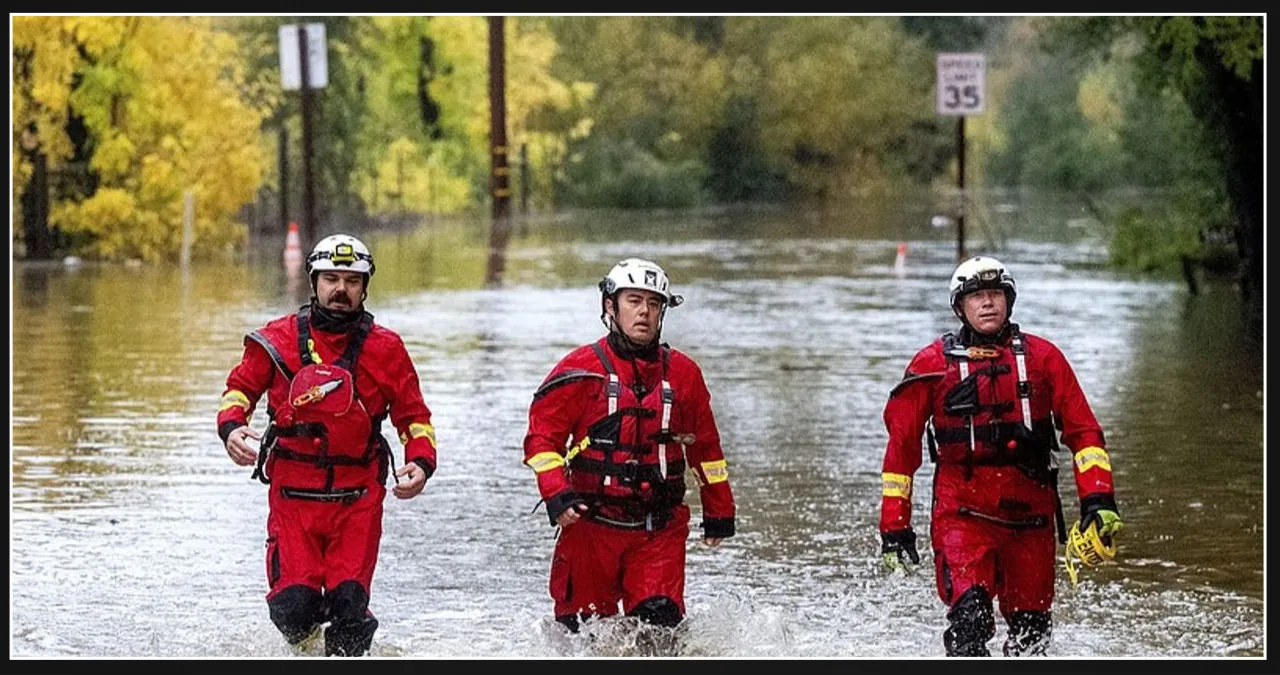A powerful storm system brought heavy snowfall and record-breaking rainfall to California, resulting in small landslides and the flooding of certain streets.
Meanwhile, on the other side of the country, blizzard and winter storm warnings were issued on Saturday for regions ranging from the Northeast to central Appalachia.
The storm hit the West Coast earlier this week, causing two fatalities and widespread power outages in the Pacific Northwest, mainly in the Seattle area. Afterward, its powerful winds made their way through Northern California.
Santa Rosa, California, experienced a record-breaking three-day period of rain, receiving approximately 12.5 inches (32 centimeters) by Friday evening, as reported by the National Weather Service in the Bay Area.
Part of the picturesque Highway 1, famously known as the Pacific Coast Highway, in Mendocino County was temporarily shut down due to flooding. The California Department of Transportation has not provided an estimated reopening time for this section of the highway.
On the East Coast, New York and New Jersey received a much-needed downpour, bringing relief to the rare wildfires that have been raging in the area. Additionally, northeastern Pennsylvania experienced heavy snowfall.
Meanwhile, parts of West Virginia were issued a blizzard warning until Saturday morning. The region was expected to receive up to 2 feet (61 centimeters) of snow accompanied by strong winds, making travel extremely dangerous.
As the weekend approached, over 112,000 individuals in the Seattle area were still experiencing power outages caused by the most powerful atmospheric river of the season.
An atmospheric river is a lengthy stream of moisture that develops over the ocean and travels through the sky before making landfall.
Efforts were underway to remove fallen power lines, branches, and other debris from the streets. Additionally, cities opened up warming centers to provide warm meals and a place for people without power to charge their cellphones and other electronic devices.
Gale warnings have been issued for the waters off Washington, Oregon, and California, while high wind warnings are currently in effect for certain areas of Northern California and Oregon. Furthermore, winter storm warnings have been issued for portions of the California Cascades and the Sierra Nevada.
According to forecasters, there is a prediction that both coasts will experience a relief from the storms. This is expected to happen as the system in the northeast makes its way towards eastern Canada, while the one in the West moves towards the south.
On Friday night, there was already some relief in California as the Humboldt County sheriff’s office downgraded evacuation orders to warnings for those near the Eel River. This decision was made after forecasters predicted that the waterway would experience moderate flooding instead of major flooding.
A powerful storm made landfall on the West Coast on Tuesday, known as a “bomb cyclone” due to its rapid intensification. The storm brought with it strong winds that caused trees to fall onto roads, vehicles, and homes.
Debra Campbell recalls sitting in the darkness, gripping a flashlight tightly, unable to find solace amidst the relentless howling winds that battered her residence in Crescent City, California. Suddenly, a deafening boom pierced the air as a colossal 150-foot tree mercilessly descended upon her house and car.
Campbell described the experience as extremely terrifying. She recalled the moment when she realized that the danger was not directly above her, allowing her to quickly grab her car keys and purse. As she opened the front door, she was met with a solid wall of trees blocking her path.
The Northeast, a region currently experiencing drought conditions, is expected to receive over 2 inches (5 centimeters) of rain by Saturday morning. In areas with higher elevations, snow may also be mixed in with the precipitation.
Despite the messy situation, the rainfall was anticipated to provide some relief to the drought-stricken state, which has experienced an unusually dry autumn.
According to Bryan Greenblatt, a meteorologist at the National Weather Service in Binghamton, New York, the upcoming melt will not completely alleviate the drought situation, but it will certainly provide some much-needed relief.
Heavy snowfall blanketed northeastern Pennsylvania, including the picturesque Pocono Mountains, leading to the closure of numerous schools.
In the higher elevations, snow accumulations reached up to 17 inches (43 centimeters), while valley cities like Scranton and Wilkes-Barre received lesser amounts.
This winter weather event left over 85,000 customers without power in 10 counties. To ensure safety, the state transportation department implemented speed restrictions on certain highways.
Technology has revolutionized the way we live, work, and communicate. It has become an integral part of our daily lives, offering convenience, efficiency, and endless possibilities.
From smartphones to social media, technology has changed the way we connect with others and access information. It has transformed industries, creating new jobs and opportunities. However, with all its benefits, technology has also brought about challenges and concerns.
It has raised questions about privacy, security, and the impact on our mental and physical well-being. As we continue to embrace technology, it is important to strike a balance and use it responsibly.

